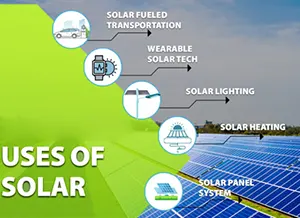
Our world’s overreliance on fossil fuels is pushing life as we know it closer to the end. And as humanity turns to renewable energy for salvation, solar energy has emerged as one of the front runners for a better, cleaner future. This is because solar power is practically inexhaustible and emits zero greenhouse gases when used.
But to become a suitable alternative, an energy source must also present a wide range of uses, enough to meet the earth’s diverse and growing energy demands. That’s probably why solar power holds the biggest potential of all renewable energy sources (excluding hydropower).
This article will explore the uses of solar energy and what potential they hold for a renewable future.
See our related article on the Pros and Cons of Solar Energy. Here we discuss the advantages and disadvantages of solar energy and let you decide if it’s really worth it.
7 Uses of Solar Energy
- To Generate electricity
- Solar Space Heating
- Solar Water Heating
- Solar Lighting
- Solar Ventilation
- To Power Portables
- Solar Transportation
To generate electricity
The world realized the sun’s potential to generate electricity with the discovery of the photovoltaic effect in the mid-late 19th century. Then in 1954, Daryl Chapin, Gerald Pearson, and Calvin Fuller of Bell Labs created the first silicon PV cell, ushering the dawn of solar electricity.
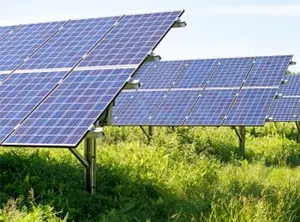
Solar energy technologies have gotten better and cheaper, with more people embracing the financial and environmental benefits of solar energy. This has made solar electricity the largest and fastest-growing application of solar energy across the United States and the world.
Preliminary data from the U.S Energy Information Administration (EIA) shows that as of February 2021, solar energy generated around 91 billion kWh of electricity in the country. This accounts for about 2.3 % of the total electricity generated, a significant jump from the 1.9% it accounted for in 2017.
A significant portion of this electricity comes from rooftop solar panels. By the end of 2019, the United States had well over 2 million solar panel installations spread out across homes and businesses. Today, the number of installations should be about 3 million, and this is expected to grow to 4 million in the next two years.
Rooftop solar installations generate electricity used to offset the owner’s usage of grid power. Any surplus electricity is sent back to the grid and reflected on the monthly utility bills in a practice known as net metering.
The electric power can also be stored in solar batteries for use after the sun sets or to provide backup power in case of an emergency. Depending on state regulations, these batteries may allow those living in areas with high-intensity sunlight to go completely off the grid.
Solar electricity is also generated in utility-scale solar PV farms (those that generate at least one megawatt) like community solar facilities. The EIA estimates that there are more than 2,500 utility-scale PV electricity generating facilities in the United States, collectively accounting for around 1.7% of annual electricity generation.
One of the disadvantages of solar energy is that these solar farms take up massive amounts of land to generate this small amount of electricity. Still, it’s much cleaner than burning fossil fuel.
Concentrated solar power (CSP) is another technology used to convert solar energy into electricity. This technique involves converting sunlight into thermal energy, which produces steam that is then used to turn a turbine that generates electricity. There are about 52 concentrating solar power plants producing around 1,815 megawatts (MW) in the United States.
Solar space heating
Solar heating is one of the oldest use of the sun’s energy and is almost as common as solar electricity. However, many people don’t even realize they’re using solar heating as it doesn’t always require sophisticated technology.
A good example is passive home solar designs, which have existed since the Roman age. They use strategic placement of windows and special building materials to circulate solar heat across a room naturally.
A more recent approach involves the use of solar thermal panels (flat plate or vacuum tube collectors) to convert sunlight into heat. Like regular PV panels, thermal panels are placed on the roof to absorb the solar energy and convert it to heat. They are usually connected to an active heating system, i.e., uses pumps to circulate liquid or air and generate heat.
Solar thermal panels are actually super-efficient, with a starting efficiency of around 90% for flat plates panels and 82% for evacuated tubes. ‘Starting’ because the efficiency gradually drops as the panel’s surface gets hotter relative to the surrounding temperature.
They are also cheaper than PV panels and carry the same environmental and cost-saving benefits typically associated with solar electricity.
Solar water heating
Solar water heating follows the same basic principle as solar space heating, i.e., converting solar radiation into heat. For everyday residential uses, this uses solar water heaters.
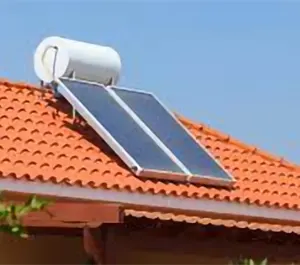
A typical solar domestic hot water system includes solar collectors and a storage tank. The collectors ( flat-plate, evacuated tube, and Integral collector-storage systems) convert sunlight to thermal energy. This energy is then used to heat water actively or passively.
According to the National Renewable Energy Laboratory, active solar-powered heating systems are more common in residential and commercial settings. They are more efficient than passive systems but come at a higher price.
Solar thermal is also emerging as a more cost-effective alternative to pool heating when compared to oil and gas pumps. A solar pool heating system uses a pump to circulate water through a filter and a collector, where it’s heated by the sun before being pumped back to the pool. There is also a flow control valve that diverts water through the collector.
See our related article where we review the Best Solar Water Heaters. Find out which one might work for you.
Solar lighting
Solar lighting is becoming an increasingly popular application of solar energy in the United States, especially in outdoor lighting. Solar lighting technologies use miniature solar panels to harness sunlight during the day. The sunlight is converted to electric energy, which is then stored in batteries and used to provide lighting at night. That way, home and business owners can meet their exterior lighting needs without drawing electricity from the grid.

Solar lighting has relatively cheap up-front installation costs and throughout its usage, is a good way to reduce electricity bills. They’re also quite easy to set up as they don’t require the complicated wiring typically associated with grid-connected lighting.
Skylights are a much older form of solar lighting. The Romans used open skylights to provide daylighting in their temple architecture. Later on, closed skylights became a common feature in European churches and cathedrals of the past century. These involved using transparent or translucent glass as part of the roof space to allow daylight into the structures.
Today, skylights are widely used in residential and commercial buildings. They allow property owners to spend less on electrical lighting during the day. Common examples include roof windows, tubular daylighting devices (TDDs), unit skylights, and sloped glazing.
Solar ventilation
Though many people automatically associate solar energy with electricity and heat, it can also be used to achieve a cooling effect. This is done through solar ventilation and made possible by using solar fans, which use solar energy to provide a constant steady flow of air in indoor spaces.
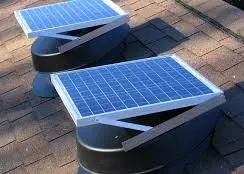
In summer, the hot sun heats up the attic to high temperatures. Some of this heat radiates downwards into the living space, causing elevated living room temperatures. Solar fans work by expelling hot air from the attic, allowing the attic to pull in the cooler outside air through existing vents.
A cool attic means little or no heat radiates into the living space, allowing homeowners to spend less on air conditioning expenses.
To power portables
The concept of portable solar power has been around for a long time, but it’s yet to be adopted into the mainstream. The technology is there, though; portable solar PV chargers to charge personal electronic devices and solar-powered watches.
In the future, it may be possible to integrate solar cells into our phones. Researchers in Japan are also working on lightweight, water-resistant solar cells that can be sewed into clothing to power small electric devices.
Solar transportation
Solar transportations may play a big role in the fight against climate change. Today, the United States Environmental Protection Agency (EPA) estimates that the typical passenger vehicle emits 4.6 metric tons of carbon dioxide a year. The BBC also estimates that the transport sectors in the United States and the United Kingdom emit more greenhouse gas than electricity and agricultural production combined.
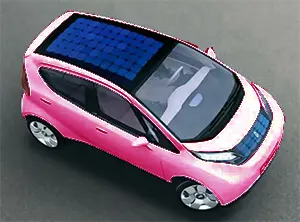
As a result, solar transportation is being explored as a possible solution to the transport sector’s carbon footprint. It is currently the most ambitious application of solar energy technologies, with some companies designing solar-powered trains, cars, yachts, and even airplanes.
In 2016 the Solar Impulse 2 became the first aircraft to circumnavigate the globe without using any fuel- it was powered by over 17,000 solar cells mounted on the wings. Bertrand Piccard flew the plane.
However, solar transportation still has a long way to go before it can become available to the average user. The technologies involved are still extremely inefficient and too expensive to go mainstream. See our related article where we discuss the possibility of having Solar Roads in the future.
